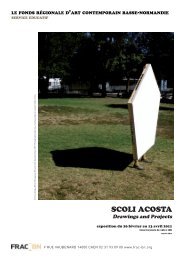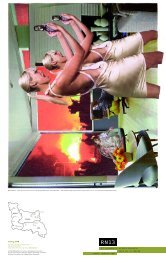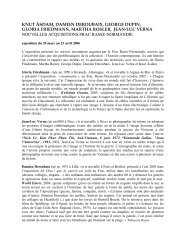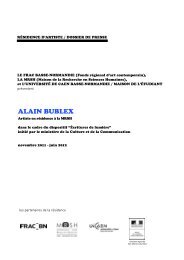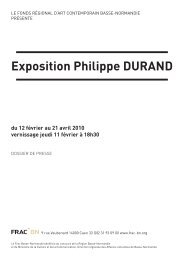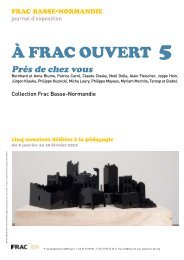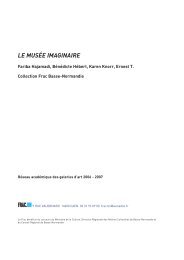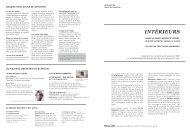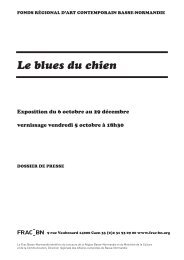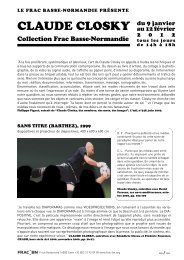APPEL A PROJETS MONUMENT TAP - FRAC Basse-Normandie
APPEL A PROJETS MONUMENT TAP - FRAC Basse-Normandie
APPEL A PROJETS MONUMENT TAP - FRAC Basse-Normandie
Create successful ePaper yourself
Turn your PDF publications into a flip-book with our unique Google optimized e-Paper software.
The town itself, bombed by the allies and 70% destroyed, nevertheless preserves some 40 churches,<br />
which acted at times as refuges for the populations and received (on the other hand) a very small<br />
number of monuments; indicated by the monument of Anna Quinquaud, 1962, which commemorates<br />
the 19 days of the battle of Caen; the work Phénix (Phoenix), 1954, of the sculptor Louis Leygue,<br />
situated at the entrance of the University, which marks the renovation of the place and of the town.<br />
Numerous little simple and decorative commemorative slabs are distributed throughout the town and<br />
pay homage to the allied forces, to the French combatants, or also, to the riflemen and prisoners.<br />
The recent public commission at the heart of the town, La Caravane (The Caravan / Retinue), a work by<br />
the contemporary artist Josep van Lieshout, which has been inaugurated recently in 2013, creates<br />
through its 11 figures, a homage which is equally dedicated to the living in times of war.<br />
The year 2014, the year of the 100 th anniversary of the 1914-1918 war and the 70 th anniversary of the<br />
Normandy landings gives the opportunity for a number of commemorative ceremonies.<br />
Le Mémorial de la Paix (The Peace Memorial) welcomes a great number of visitors.<br />
http://www.memorial-caen.fr/portail/index.php?option=com_content&view=article&id=788&Itemid=1295<br />
Frac BN<br />
Fonds regional d’art contemporain <strong>Basse</strong>-<strong>Normandie</strong><br />
9 rue Vaubenard 14000 Caen<br />
France<br />
www.frac-bn.org<br />
Contact : Sylvie Froux, directrice<br />
CALAIS, FINE ART MUSEUM<br />
In Calais the monument exists almost exclusively in relation to war. Few buildings survived bombings by<br />
English allies of 1940. The old town of Calais has lost 80% of its architecture. Among the remains are<br />
the Tour du Guet, the ancient lighthouse, small remains of Notre Dame de Calais, the monumental<br />
church in Tudor style in course of restoration and almost complete. Monumental and traditional<br />
sculpture is largely confined to parks and public spaces. The town is remarkable for its numerous<br />
fortifications from the Ancien Regime, and for its bunkers of the 20 th century, mostly in ruins. They<br />
punctuate the town, the beach, the banks of the canals. Of the defensive structures constructed<br />
between 1940 and 1942 by the Germans for protecting against attack by the English, only one survives<br />
in use. It contains the museum to the memory of the 39-45 war, camouflaged behind the trees of a<br />
park. Defensive architecture has over the centuries transformed the countryside around Calais. The<br />
bunkers within this frontier town by the sea impose a strong presence in spite of their ruinous state.<br />
Evidence of its dominance by war for a whole epoch, the bunker of the Pas de Calais was erected as a<br />
central point of the defensive and offensive strategy for the whole Nazi war without ever having served<br />
as such. Today the bunkers are rehabilitated as a war museum, and of which the outline structure as<br />
well as the firing shafts are much visited by school-children and tourists.<br />
Another Calais monument, the Burghers of Calais of 1888, recalls the tumultuous history of the Franco-<br />
British conflicts during the Hundred Years War. In effect, Rodin chose to represent an episode from the



